Dual Frequency Orbiter-Radar System for the Observation of Seas and Tides on Titan: Extraterrestrial Oceanography from Satellite
Abstract
1. Introduction
2. Materials and Methods
2.1. Bathymetric Measurements of Titan’s Seas
2.2. Proposed System: Dual-Frequency Ka/X Bands Multimode Radar Orbiter
2.3. High-Resolution SAR and Interferometry Mode
2.4. Interferometric System
2.5. Tides Measurements and Global Topography
3. Discussion and Results
3.1. Sounding Mode Operative Frequency Optimization
3.2. Tides Estimation Using Repeated Ground Tracks: Simulation and Results
4. Conclusions
Funding
Acknowledgments
Conflicts of Interest
References
- Elachi, C.; Allison, M.D.; Borgarelli, L.; Encrenaz, P.; Im, E.; Janssen, M.A.; Johnson, W.T.K.; Kirk, R.L.; Lorenz, R.D.; Lunine, J.I.; et al. Radar: The Cassini Titan Radar Mapper. Space Sci. Rev. 2004, 115, 71–110. [Google Scholar] [CrossRef]
- Mastrogiuseppe, M.; Poggiali, V.; Seu, R.; Martufi, R.; Notarnicola, C. Titan dune heights retrieval by using Cassini Radar Altimeter. Icarus 2014, 230, 191–197. [Google Scholar] [CrossRef]
- Le Gall, A.; Janssen, M.; Wye, L.; Hayes, A.; Radebaugh, J.; Savage, C.; Zebker, H.; Lorenz, R.; Lunine, J.; Kirk, R.; et al. Cassini SAR, radiometry, scatterometry and altimetry observations of Titan’s dune fields. Icarus 2011, 213, 608–624. [Google Scholar] [CrossRef]
- Rodriguez, S.; García, A.; Lucas, A.; Appéré, T.; Le Gall, A.; Reffet, E.; Le Corre, L.; Le Mouélic, S.; Cornet, T.; Du Pont, S.C.; et al. Global mapping and characterization of Titan’s dune fields with Cassini: Correlation between RADAR and VIMS observations. Icarus 2014, 230, 168–179. [Google Scholar] [CrossRef]
- Lorenz, R.D. The Sand Seas of Titan: Cassini RADAR Observations of Longitudinal Dunes. Science 2006, 312, 724–727. [Google Scholar] [CrossRef]
- Radebaugh, J.; Lorenz, R.D.; Lunine, J.I.; Lunine, S.D.; Wall, G.; Boubin, E.; Reffet, R.L.; Kirk, R.M.; Lopes, E.R.; Stofan, L.; et al. Spencer, and Cassini Radar Team,: Dunes on Titan observed by Cassini Radar. Icarus 2008, 194, 690–703. [Google Scholar] [CrossRef]
- Poggiali, V.; Mastrogiuseppe, M.; Callegari, M.; Martufi, R.; Seu, R.; Casarano, D.; Pasolli, L.; Notarnicola, C. Synergy of Cassini SAR and altimeter acquisitions for the retrieval of dune field characteristics on Titan. In Proceedings of the SPIE 8536, SAR Image Analysis, Modeling, and Techniques XII, Prague, Czech Republic, 21–22 September 2012; Volume 853608. [Google Scholar]
- Callegari, M.; Casarano, D.; Mastrogiuseppe, M.; Poggiali, V.; Notarnicola, C. Dune Height Estimation on Titan Exploiting Pairs of Synthetic Aperture Radar Images With Different Observation Angles. IEEE J. Sel. Top. Appl. Earth Obs. Remote Sens. 2015, 8, 1295–1306. [Google Scholar] [CrossRef]
- Le Gall, A.; Hayes, A.; Ewing, R.; Janssen, M.; Radebaugh, J.; Savage, C.; Encrenaz, P. Latitudinal and altitudinal controls of Titan’s dune field morphometry. Icarus 2012, 217, 231–242. [Google Scholar] [CrossRef]
- Bonnefoy, L.E.; Hayes, A.G.; Hayne, P.O.; Malaska, M.J.; Le Gall, A.; Solomonidou, A.; Lucas, A. Compositional and spatial variations in Titan dune and interdune regions from Cassini VIMS and RADAR. Icarus 2016, 270, 222–237. [Google Scholar] [CrossRef]
- Radebaugh, J.; Lorenz, R.D.; Kirk, R.L.; Lunine, J.I.; Stofan, E.R.; Lopes, R.M.; Wall, S.D. Mountains on Titan observed by Cassini Radar. Icarus 2007, 192, 77–91. [Google Scholar] [CrossRef]
- Mitri, G.; Bland, M.T.; Showman, A.P.; Radebaugh, J.; Stiles, B.; Lopes, R.M.C.; Lunine, J.I.; Pappalardo, R.T. Mountains on Titan: Modeling and observations. J. Geophys. Res. Space Phys. 2010, 115, 115. [Google Scholar] [CrossRef]
- Barnes, J.W.; Radebaugh, J.; Brown, R.H.; Wall, S.; Soderblom, L.; Lunine, J.; Burr, D.; Sotin, C.; Le Mouélic, S.; Rodriguez, S.; et al. Near-infrared spectral mapping of Titan’s mountains and channels. J. Geophys. Res. Space Phys. 2007, 112. [Google Scholar] [CrossRef]
- Wood, C.A.; Lorenz, R.; Kirk, R.; Lopes, R.; Mitchell, K.; Stofan, E. Impact craters on Titan. Icarus 2010, 206, 334–344. [Google Scholar] [CrossRef]
- Lopes, R.M.C.; Kirk, R.L.; Mitchell, K.L.; LeGall, A.; Barnes, J.W.; Hayes, A.; Kargel, J.; Wye, L.; Radebaugh, J.; Stofan, E.R.; et al. Cryovolcanism on Titan: New results from Cassini RADAR and VIMS. J. Geophys. Res. Planets 2013, 118, 416–435. [Google Scholar] [CrossRef]
- Hayes, A.G.; Birch, S.P.D.; Dietrich, W.E.; Howard, A.D.; Kirk, R.L.; Poggiali, V.; Mastrogiuseppe, M.; Michaelides, R.J.; Corlies, P.M.; Moore, J.M.; et al. Topographic Constraints on the Evolution and Connectivity of Titan’s Lacustrine Basins. Geophys. Res. Lett. 2017, 44, 745–753. [Google Scholar] [CrossRef]
- Michaelides, R.; Hayes, A.; Mastrogiuseppe, M.; Zebker, H.; Farr, T.; Malaska, M.; Poggiali, V.; Mullen, J.; Farr, T.; Malaska, M. Constraining the physical properties of Titan’s empty lake basins using nadir and off-nadir Cassini RADAR backscatter. Icarus 2016, 270, 57–66. [Google Scholar] [CrossRef]
- Birch, S.P.D.; Hayes, A.G.; Poggiali, V.; Hofgartner, J.D.; Lunine, J.I.; Malaska, M.J.; Wall, S.; Lopes, R.M.C.; White, O. Raised Rims Around Titan’s Sharp-Edged Depressions. Geophys. Res. Lett. 2019, 46, 5846–5854. [Google Scholar] [CrossRef]
- Solomonidou, A.; Le Gall, A.; Malaska, M.J.; Birch, S.P.D.; Lopes, R.M.C.; Coustenis, A.; Rodriguez, S.; Wall, S.D.; Michaelides, R.J.; Nasr, M.R.; et al. Spectral and emissivity analysis of the raised ramparts around Titan’s northern lakes. Icarus 2019. [Google Scholar] [CrossRef]
- Mitri, G.; Lunine, J.I.; Mastrogiuseppe, M.; Poggiali, V. Possoble exlpotion crater origin of small lake basins with raised rims on Titan. Nat. Geosci. 2019. [Google Scholar] [CrossRef]
- Stofan, E.R.; Elachi, C.; Lunine, J.I.; Lorenz, R.D.; Stiles, B.; Mitchell, K.L.; Ostro, S.; Soderblom, L.; Wood, C.; Zebker, H.; et al. The lakes of Titan. Nature 2007, 445, 61–64. [Google Scholar] [CrossRef]
- Lunine, J.I.; Atreya, S. The Methane Cycle on Titan. Nat. Geosci. 2008, 1, 159–162. [Google Scholar] [CrossRef]
- Hayes, A.; Aharonson, O.; Callahan, P.; Elachi, C.; Gim, Y.; Kirk, R.; Lewis, K.; Lopes, R.; Lorenz, R.; Lunine, J.; et al. Hydrocarbon lakes on Titan: Distribution and interaction with a porous regolith. Geophys. Res. Lett. 2008, 35. [Google Scholar] [CrossRef]
- Birch, S.P.D.; Hayes, A.G.; Dietrich, W.E.; Howard, A.D.; Bristow, C.S.; Malaska, M.J.; Moore, J.M.; Mastrogiuseppe, M.; Hofgartner, J.D.; Williams, D.A.; et al. Geomorphologic Mapping of Titan’s polar terrains: Constraining Surface Processes and Landscape Evolution. Icarus 2017, 282, 214–236. [Google Scholar] [CrossRef]
- Mastrogiuseppe, M.; Poggiali, V.; Hayes, A.; Lorenz, R.; Lunine, J.; Picardi, G.; Seu, R.; Flamini, E.; Mitri, G.; Notarnicola, C.; et al. The bathymetry of a Titan sea. Geophys. Res. Lett. 2014, 41, 1432–1437. [Google Scholar] [CrossRef]
- Mastrogiuseppe, M.; Poggiali, V.; Hayes, A.G.; Lunine, J.I.; Seu, R.; Di Achille, G.; Lorenz, R.D. Cassini radar observation of Punga Mare and environs: Bathymetry and composition. Earth Planet. Sci. Lett. 2018, 496, 89–95. [Google Scholar] [CrossRef]
- Mastrogiuseppe, M.; Poggiali, V.; Hayes, A.G.; Lunine, J.I.; Seu, R.; Mitri, G.; Lorenz, R.D. Deep and methane-rich lakes on Titan. Nat. Astron. 2019, 3, 535–542. [Google Scholar] [CrossRef]
- Wye, L.C.; Zebker, H.A.; Lorenz, R.D. Smoothness of Titan’s Ontario Lacus: Constraints from Cassini RADAR specular reflection data. Geophys. Res. Lett. 2009, 36, 16201. [Google Scholar] [CrossRef]
- Zebker, H.; Hayes, A.; Janssen, M.; Le Gall, A.; Lorenz, R.; Wye, L. Surface of Ligeia Mare, Titan, from Cassini altimeter and radiometer analysis. Geophys. Res. Lett. 2014, 41, 308–313. [Google Scholar] [CrossRef]
- Grima, C.; Mastrogiuseppe, M.; Hayes, A.G.; Wall, S.D.; Lorenz, R.D.; Hofgartner, J.D.; Stiles, B.C.; Elachi, C. The Cassini RADAR Team. Surface roughness of Titan’s hydrocarbon seas. Earth Planet. Sci. Lett. 2017, 474, 20–24. [Google Scholar] [CrossRef]
- Poggiali, V.; Mastrogiuseppe, M.; Hayes, A.G.; Seu, R.; Birch, S.P.D.; Lorenz, R.; Grima, C.; Hofgartner, J.D. Liquid-filled canyons on Titan. Geophys. Res. Lett. 2016, 43, 7887–7894. [Google Scholar] [CrossRef]
- Lorenz, R.D. The flushing of Ligeia: Composition variations across Titan’s seas in a simple hydrological model. Geophys. Res. Lett. 2014, 41, 5764–5770. [Google Scholar] [CrossRef]
- Tan, S.P.; Kargel, J.S.; Jennings, D.E.; Mastrogiuseppe, M.; Adidharma, H.; Marion, G.M. Titan’s liquids: Exotic behavior and its implications on global fluid circulation. Icarus 2015, 250, 64–75. [Google Scholar] [CrossRef]
- Tokano, T.; Lorenz, R.D. Modeling of Seasonal Lake Level Fluctuations of Titan’s Seas/Lakes. J. Geophys. Res. Planets 2019, 124, 617–635. [Google Scholar] [CrossRef]
- Corlies, P.; Hayes, A.G.; Birch, S.P.D.; Lorenz, R.; Stiles, B.W.; Kirk, R.; Poggiali, V.; Zebker, H.; Iess, L. Titan’s Topography and Shape at the End of the Cassini Mission. Geophys. Res. Lett. 2017, 44, 754–761. [Google Scholar] [CrossRef]
- Poggiali, V.; Mastrogiuseppe, M.; Hayes, A.G.; Seu, R.; Mullen, J.P.; Birch, S.P.D.; Raguso, M.C. High-Resolution Topography of Titan adapting the Delay/Doppler Algorithm to the Cassini RADAR Altimeter Data. IEEE Trans. Geosci. Remote Sens. 2019. [Google Scholar] [CrossRef]
- Hayes, A.; Aharonson, O.; Lunine, J.; Kirk, R.; Zebker, H.; Wye, L.; Lorenz, R.; Turtle, E.; Paillou, P.; Mitri, G.; et al. Transient surface liquid in Titan’s polar regions from Cassini. Icarus 2011, 211, 655–671. [Google Scholar] [CrossRef]
- Hofgartner, J.D.; Hayes, A.G.; Lunine, J.I.; Zebker, H.; Lorenz, R.D.; Malaska, M.J.; Mastrogiuseppe, M.; Notarnicola, C.; Soderblom, J.M. Titan’s “Magic Islands”: Transient features in a hydrocarbon sea. Icarus 2016, 271, 338–349. [Google Scholar] [CrossRef]
- Lunine, J.I.; Lorenz, R.D. Rivers, Lakes, Dunes, and Rain: Crustal Processes in Titan’s Methane Cycle. Annu. Rev. Earth Planet. Sci. 2009, 37, 299–320. [Google Scholar] [CrossRef]
- Thompson, W.; Squyres, S.W. Titan and other icy satellites: Dielectric properties of constituent materials and implications for radar sounding. Icarus 1990, 86, 336–354. [Google Scholar] [CrossRef]
- Picardi, G.; Seu, R.; Coradini, A.; Zampolini, E.; Ciaffone, A. Radar geomorphologic characterization of Titan. In Proceedings of the 92 International Conference on Rader, Brighton, UK, 12–13 October 1992; IET: London, UK, 1992; pp. 254–257. [Google Scholar]
- Ori, G.; Marinangeli, L.; Baliva, A.; Bressan, M.; Strom, R. Dynamics of liquid on Titan surface. Planet. Space Sci. 1998, 46, 1417–1421. [Google Scholar] [CrossRef]
- Campbell, D.B.; Black, G.J.; Carter, L.M.; Ostro, S.J. Radar Evidence for Liquid Surfaces on Titan. Science 2003, 302, 431–434. [Google Scholar] [CrossRef]
- Birch, S.; Hayes, A.; Corlies, P.; Stofan, E.; Hofgartner, J.; Lopes, R.; Lorenz, R.; Lunine, J.; MacKenzie, S.; Malaska, M.; et al. Morphological evidence that Titan’s southern hemisphere basins are paleoseas. Icarus 2018, 310, 140–148. [Google Scholar] [CrossRef]
- Aharonson, O.; Hayes, A.G.; Lunine, J.I.; Lorenz, R.D.; Allison, M.D.; Elachi, C. An asymmetric distribution of lakes on Titan as a possible consequence of orbital forcing. Nat. Geosci. 2009, 2, 851–854. [Google Scholar] [CrossRef]
- Hayes, A.G.; Wolf, A.S.; Aharonson, O.; Zebker, H.; Lorenz, R.; Kirk, R.L.; Paillou, P.; Lunine, J.; Wye, L.; Callahan, P.; et al. Bathymetry and absorptivity of Titan’s Ontario Lacus. J. Geophys. Res. 2010, 115. [Google Scholar] [CrossRef]
- Ventura, B.; Notarnicola, C.; Casarano, D.; Posa, F.; Hayes, A.G.; Wye, L. Electromagnetic models and inversion techniques for Titan’s Ontario Lacus depth estimation from Cassini RADAR data. Icarus 2012, 221, 960–969. [Google Scholar] [CrossRef]
- Cordier, D.; Mousis, O.; Lunine, J.I.; Lebonnois, S.; Rannou, P.; Lavvas, P.; Lobo, L.Q.; Ferreira, A.G.M. Titan’s lakes chemical composition: Sources of uncertainties and variability. Planet. Space Sci. 2012, 61, 99–107. [Google Scholar] [CrossRef]
- Cordier, D.; Mousis, O.; Lunine, J.I.; Lavvas, P.; Vuitton, V. An estimate of the chemical composition of titan’s lakes. Astrophys. J. 2009, 707, 128–131. [Google Scholar] [CrossRef]
- Mastrogiuseppe, M.; Hayes, A.; Poggiali, V.; Seu, R.; Lunine, J.I.; Hofgartner, J.D. Radar Sounding Using Cassini Altimeter: Waveform Modelling and Monte Carlo approach for Data Inversion of Observation of Titan’s seas. IEEE Trans. Geosci. Remote Sens. 2016, 54, 5646–5656. [Google Scholar] [CrossRef]
- Mitchell, K.L.; Barmatz, M.B.; Jamieson, C.S.; Lorenz, R.D.; Lunine, J.I. Laboratory measurements of cryogenic liquid alkane microwave absorptivity and implications for the composition of Ligeia Mare, Titan. Geophys. Res. Lett. 2015, 42, 1340–1345. [Google Scholar] [CrossRef]
- Malaska, M.J.; Hodyss, R.; Lunine, J.I.; Hayes, A.G.; Hofgartner, J.D.; Hollyday, G.; Lorenz, R.D. Laboratory measurements of nitrogen dissolution in Titan lake fluids. Icarus 2017, 289, 94–105. [Google Scholar] [CrossRef]
- Mastrogiuseppe, M.; Hayes, A.G.; Poggiali, V.; Lunine, J.I.; Lorenz, R.D.; Seu, R.; Le Gall, A.; Notarnicola, C.; Mitchell, K.L.; Malaska, M.; et al. Bathymetry and composition of Titan’s Ontario Lacus derived from Monte Carlo-based waveform inversion of Cassini RADAR altimetry data. Icarus 2018, 300, 203–209. [Google Scholar] [CrossRef]
- Raguso, M.C.; Mastrogiuseppe, M.; Seu, R.; Piazzo, L. Super Resolution and Interferences Suppression Technique Applied to SHARAD Data. In Proceedings of the 2018 5th IEEE International Workshop on Metrology for AeroSpace (MetroAeroSpace), Rome, Italy, 20–22 June 2018; pp. 242–246. [Google Scholar]
- Raguso, M.C.; Piazzo, L.; Mastrogiuseppe, M.; Seu, R.; Orosei, R. Resolution Enhancement and Interference Suppression for Planetary Radar Sounders. In Proceedings of the 2018 26th European Signal Processing Conference (EUSIPCO), Rome, Italy, 3–7 September 2018; pp. 1212–1216. [Google Scholar]
- Brown, R.H.; Soderblom, L.A.; Soderblom, J.M.; Clark, R.N.; Jaumann, R.; Barnes, J.W.; Sotin, C.; Buratti, B.; Baines, K.H.; Nicholson, P.D. The identification of liquid ethane in Titan’s Ontario Lacus. Nature 2008, 454, 607–610. [Google Scholar] [CrossRef]
- Wall, S.; Hayes, A.; Bristow, C.; Lorenz, R.; Stofan, E.; Lunine, J.; Le Gall, A.; Janssen, M.; Lopes, R.; Wye, L.; et al. Active shoreline of Ontario Lacus, Titan: A morphological study of the lake and its surroundings. Geophys. Res. Lett. 2010, 37. [Google Scholar] [CrossRef]
- Cornet, T.; Bourgeois, O.; Le Mouélic, S.; Rodriguez, S.; Lopez Gonzalez, T.; Sotin, C.; Tobie, G.; Fleurant, C.; Barnes, J.W.; Brown, R.H. Geomorphological significance of Ontario Lacus on Titan: Integrated interpretation of Cassini VIMS, ISS and RADAR data and comparison with the Etosha Pan (Namibia). Icarus 2012, 218, 788–806. [Google Scholar] [CrossRef]
- Mitri, G.; Coustenis, A.; Fanchini, G.; Hayes, A.G.; Iess, L.; Khurana, K.; Lebreton, J.-P.; Lopes, R.M.; Lorenz, R.D.; Meriggiola, R.; et al. The exploration of Titan with an orbiter and a lake probe. Planet. Space Sci. 2014, 104, 78–92. [Google Scholar] [CrossRef]
- Lorenz, R.D.; Oleson, S.R.; Colozza, A.J.; Jones, R.; Packard, T.; Hartwig, J.; Newman, J.M.; Gyekenyesi, J.Z.; Schmitz, P.; Walsh, J. Exploring Titan’s cryogenic hydrocarbon seas with boat-deployed expendable dropsondes. Adv. Space Res. 2018, 62, 912–920. [Google Scholar] [CrossRef]
- Coradini, A.; Cramarossa, R.; Lombardo, P.; Picardi, G.; Seu, R. Topographic mapping of the moon via a radar system. EARSeL 1995, 4, 67–75. [Google Scholar]
- Hensley, S.; Shaffer, S. Repeat pass radar observations of Venus from the Magellan Radar System. In Proceedings of the Lunar and Planetary Science Conference, Woodlands, TX, USA, 1–5 March 2010. [Google Scholar]
- Iess, L.; Jacobson, R.A.; Ducci, M.; Stevenson, D.J.; Lunine, J.I.; Armstrong, J.W.; Asmar, S.W.; Racioppa, P.; Rappaport, N.J.; Tortora, P. The tides of Titan. Science 2012, 337, 457. [Google Scholar] [CrossRef]
- Lorenz, R.D.; Stiles, B.W.; Kirk, R.L.; Allison, M.D.; del Marmo, P.P.; Iess, L.; Lunine, J.I.; Ostro, S.J.; Hensley, S. Titan’s rotation reveals an internal ocean and changing zonal winds. Science 2008, 319, 1649–1651. [Google Scholar] [CrossRef]
- Bills, B.G.; Nimmo, F. Rotational dynamics and internal structure of Titan. Icarus 2011, 214, 351–355. [Google Scholar] [CrossRef]
- Tobie, G.; Lunine, J.I.; Sotin, C. Episodic outgassing as the origin of atmospheric methane on Titan. Nature 2006, 440, 61–64. [Google Scholar] [CrossRef]
- Lunine, J.I. Saturn’s Titan: A Strict Test for Life’s Cosmic Ubiquity. Proc. Am. Philos. Soc. 2009, 153, 403–418. [Google Scholar]
- Lorenz, R.D.; Lunine, J.I.; McKay, C.P. Titan under a red giant sun: A new kind of “habitable” moon. Geophys. Res. Lett. 1997, 24, 2905–2908. [Google Scholar] [CrossRef]
- Hemingway, D.; Nimmo, F.; Zebker, H.; Iess, L. A rigid and weathered ice shell on Titan. Nature 2013, 500, 550–552. [Google Scholar] [CrossRef]
- Beghin, C.; Sotin, C.; Hemelin, M. Titan’s native ocean revealed beneath some 45 km of ice by Schumann-like resonance. C. R. Geosci. 2010, 342, 425–433. [Google Scholar] [CrossRef]
- Picardi, G.; Plaut, J.J.; Biccari, D.; Bombaci, O.; Calabrese, D.; Cartacci, M.; Cicchetti, A.; Clifford, S.M.; Edenhofer, P.; Farrell, W.M.; et al. Radar Soundings of the Subsurface of Mars. Science 2005, 310, 1925. [Google Scholar] [CrossRef]
- Seu, R.; Phillips, R.J.; Biccari, D.; Orosei, R.; Masdea, A.; Picardi, G.; Safaeinili, A.; Campbell, B.A.; Plaut, J.J.; Marinangeli, L.; et al. SHARAD sounding radar on the Mars Reconnaissance Orbiter. J. Geophys. Res. Space Phys. 2007, 112, 5. [Google Scholar] [CrossRef]
- Notaro, V.; Durante, D.; Iess, L. On the determination of Jupiter’s satellite-dependent Love numbers from Juno gravity data. Planet. Space Sci. 2019, 175, 34–40. [Google Scholar] [CrossRef]
- Mitri, G.; Meriggiola, R.; Hayes, A.; Lefèvre, A.; Tobie, G.; Genova, A.; Lunine, J.I.; Zebker, H. Shape, topography, gravity anomalies and tidal deformation of Titan. Icarus 2014, 236, 169–177. [Google Scholar] [CrossRef]
- Sagan, C.; Dermott, S.F. The tide in the seas of Titan. Nature 1982, 300, 731–733. [Google Scholar] [CrossRef]
- Tokano, T. Simulation of tides in hydrocarbon lakes on Saturn’s moon Titan. Ocean Dyn. 2010, 60, 803–817. [Google Scholar] [CrossRef]
- Lorenz, R. Winds and tides of Ligeia Mare, with application to the drift of the proposed time TiME (Titan Mare Explorer) capsule. Planet. Space Sci. 2012, 60, 72–85. [Google Scholar] [CrossRef]
- Vincent, D.; Karatekin, Ö.; Vallaeys, V.; Hayes, A.G.; Mastrogiuseppe, M.; Notarnicola, C.; Dehant, V.; Deleersnijder, E. Numerical study of tides in Ontario Lacus, a hydrocarbon lake on the surface of the Saturnian moon Titan. Ocean Dyn. 2016, 66, 461–482. [Google Scholar] [CrossRef]
- Sotin, C.; Barnes, J.W.; Lawrence, K.J.; Soderblom, J.M.; Audi, E.; Brown, R.H.; Le Mouelic, S.; Baines, K.H.; Buratti, B.J.; Clark, R.N.; et al. Bright, tidal currents between Titan’s seas detected by solar glints. In Proceedings of the AGU Fall Meeting Abstracts, San Francisco, CA, USA, 14–18 December 2015. Abstruct P12B-04. [Google Scholar]
- Hayes, A.G. The Lakes and Seas of Titan. Annu. Rev. Earth Planet. Sci. 2016, 44, 57–83. [Google Scholar] [CrossRef]
- Wahr, J.M.; Zuber, M.T.; Smith, D.E.; Lunine, J.I. Tides on Europa, and the thickness of Europa’s icy shell. J. Geophys. Res. 2006, 111, E12005. [Google Scholar] [CrossRef]
- Zieger, A.R.; Hancock, D.W.; Hayne, G.S.; Purdy, C.L. NASA Radar Altimeter for the TOPEX/POSEIDON Project. Proc. IEEE 1991, 79, 810–826. [Google Scholar] [CrossRef]
- Egbert, G.D.; Bennett, A.F.; Foreman, M.G.G. TOPEX/POSEIDON tides estimated using a global inverse model. J. Geophys. Res. Space Phys. 1994, 99, 24821. [Google Scholar] [CrossRef]
- Shum, C.K.; Woodworth, P.L.; Andersen, O.B.; Egbert, G.D.; Francis, O.; King, C.; Klosko, S.M.; Le Provost, C.; Li, X.; Molines, J.M.; et al. Accuracy Assessment of Recent Ocean Tide Models. J. Geophys. Res. 1997, 102, 173–194. [Google Scholar] [CrossRef]
- Wagner, C.A. A Refined M2, Tide from GEOSAT Altimetry; NOAA Technical Report NOS 136 NGS 48; NOAA: Silver Spring, MD, USA, 1991.
- Carter, L.M.; Campbell, B.A.; Holt, J.W.; Phillips, R.J.; Putzig, N.E.; Mattei, S.; Seu, R.; Okubo, C.H.; Egan, A.F. Dielectric properties of lava flows west of Ascraeus Mons, Mars. Geophys. Res. Lett. 2009, 36. [Google Scholar] [CrossRef]
- Campbell, B.; Carter, L.; Phillips, R.; Plaut, J.; Putzig, N.; Safaeinili, A.; Seu, R.; Biccari, D.; Egan, A.; Orosei, R. SHARAD radar sounding of the Vastitas Borealis Formation in Amazonis Planitia. J. Geophys. Res. Space Phys. 2008, 113. [Google Scholar] [CrossRef]
- Campbell, B.A.; Morgan, G.A. Fine-Scale Layering of Mars Polar Deposits and Signatures of Ice Content in Nonpolar Material From Multiband SHARAD Data Processing. Geophys. Res. Lett. 2018, 45, 1759–1766. [Google Scholar] [CrossRef]
- Le Gall, A.; Malaska, M.; Lorenz, R.; Janssen, M.; Tokano, T.; Hayes, A.; Mastrogiuseppe, M.; Lunine, J.; Veyssière, G.; Encrenaz, P.; et al. Composition, seasonal change, and bathymetry of Ligeia Mare, Titan, derived from its microwave thermal emission. J. Geophys. Res. Planets 2016, 121, 233–251. [Google Scholar] [CrossRef]
- Janssen, M.; Le Gall, A.; Lopes, R.; Lorenz, R.; Malaska, M.; Hayes, A.; Neish, C.; Solomonidou, A.; Mitchell, K.; Radebaugh, J.; et al. Titan’s surface at 2.18-cm wavelength imaged by the Cassini RADAR radiometer: Results and interpretations through the first ten years of observation. Icarus 2016, 270, 443–459. [Google Scholar] [CrossRef]
- Zhang, Z.; Hagfors, T.; Nielsen, E.; Picardi, G.; Mesdea, A.; Plaut, J.J. Dielectric properties of the Martian south polar layered deposits: MARSIS data inversion using Bayesian inference and genetic algorithm. J. Geophys. Res. Planets 2008, 113, 5004. [Google Scholar] [CrossRef]
- Bucciarelli, T.; Cacopardi, S.; Picardi, G.; Seu, R.; Levrini, G.; Perfetti, R. Tracking algorithms in radar altimetry. In Proceedings of the International Geoscience and Remote Sensing Symposium, Edinburgh, UK, 12–16 September 1988; pp. 973–976. [Google Scholar]
- Lopes, R.M.C.; Wall, S.D.; Elachi, C.; Birch, S.P.D.; Corlies, P.; Coustenis, A.; Hayes, A.G.; Hofgartner, J.D.; Janssen, M.A.; Kirk, R.L.; et al. Titan as Revealed by the Cassini Radar. Space Sci. Rev. 2019, 215, 33. [Google Scholar] [CrossRef]
- Nixon, C.; Lorenz, R.; Achterberg, R.; Buch, A.; Coll, P.; Clark, R.; Courtin, R.; Hayes, A.; Iess, L.; Johnson, R.; et al. Titan’s cold case files-Outstanding questions after Cassini-Huygens. Planet. Space Sci. 2018, 155, 50–72. [Google Scholar] [CrossRef]
- Bruzzone, L.; Plaut, J.J.; Alberti, G.; Blankenship, D.D.; Bovolo, F.; Campbell, B.A.; Ferro, A.; Gim, Y.; Kofman, W.; Komatsu, G.; et al. RIME: Radar for icy moon exploration. In Proceedings of the IEEE IGARSS, Melbourne, Australia, 13–18 July 2013; pp. 3907–3910. [Google Scholar] [CrossRef]
- Sambuelli, L.; Bava, S. Case study: A GPR survey on a morainic lake in northern Italy for bathymetry, water volume and sediment characterization. J. Appl. Geophys. 2012, 81, 48–56. [Google Scholar] [CrossRef]
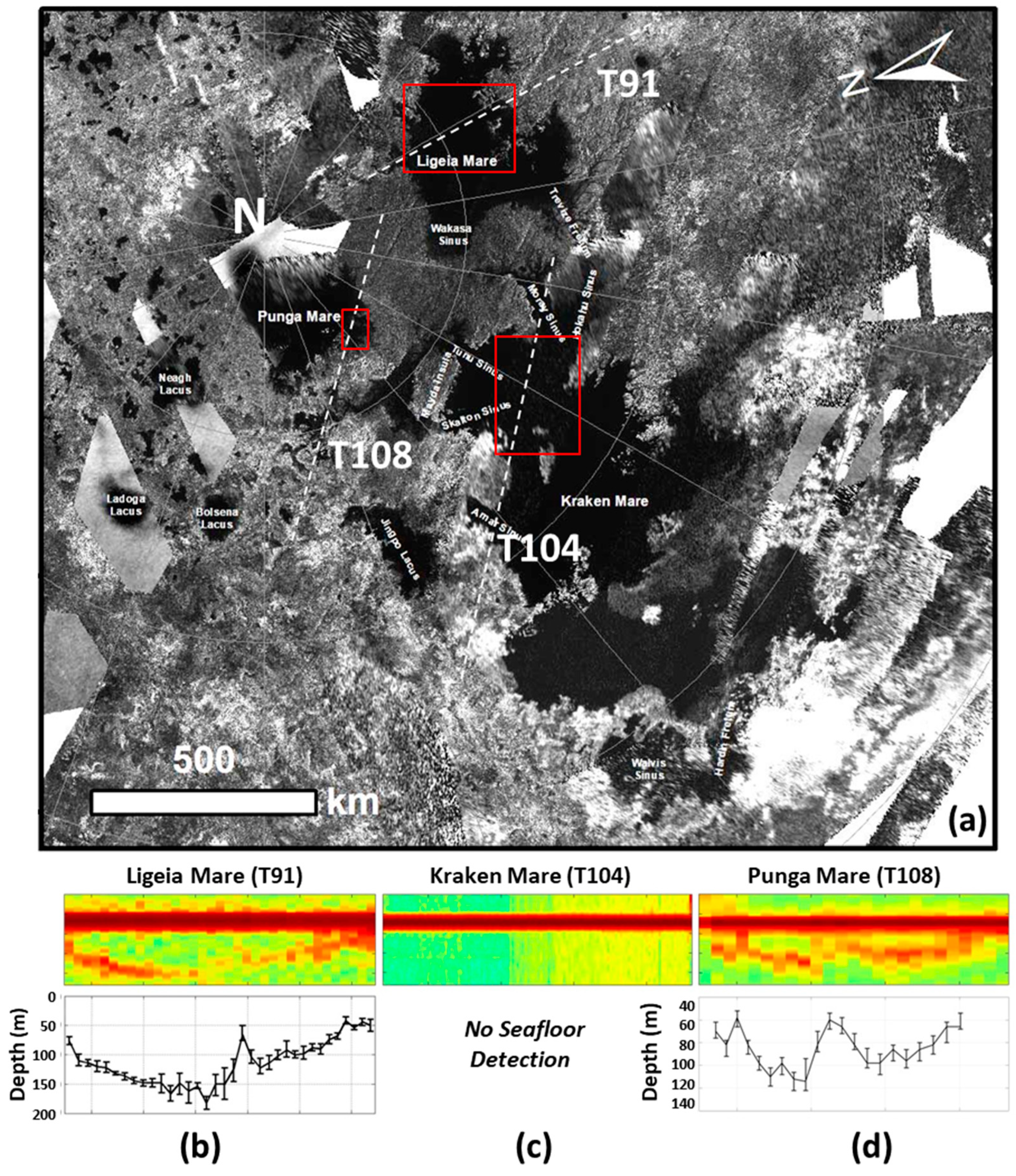
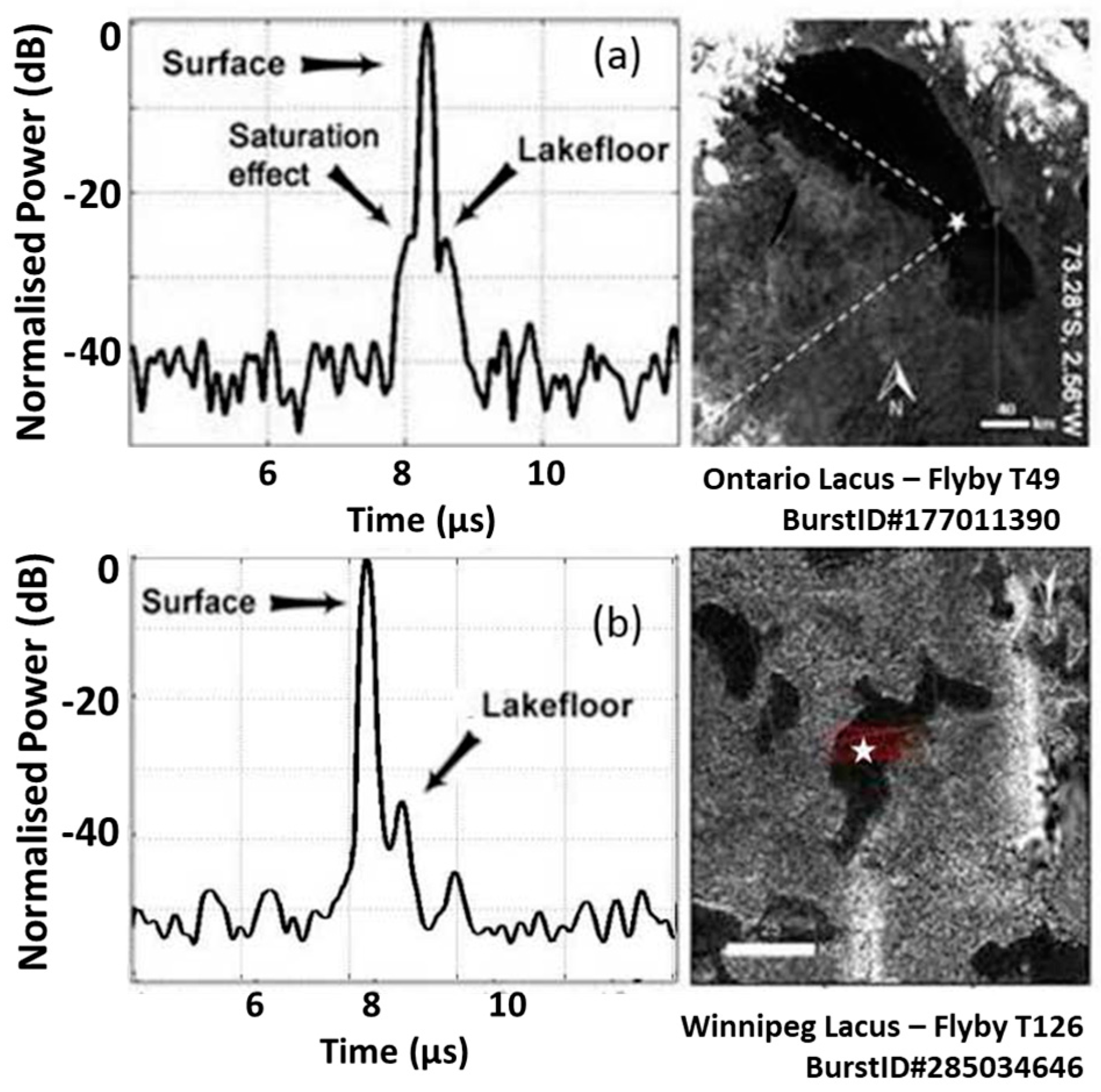
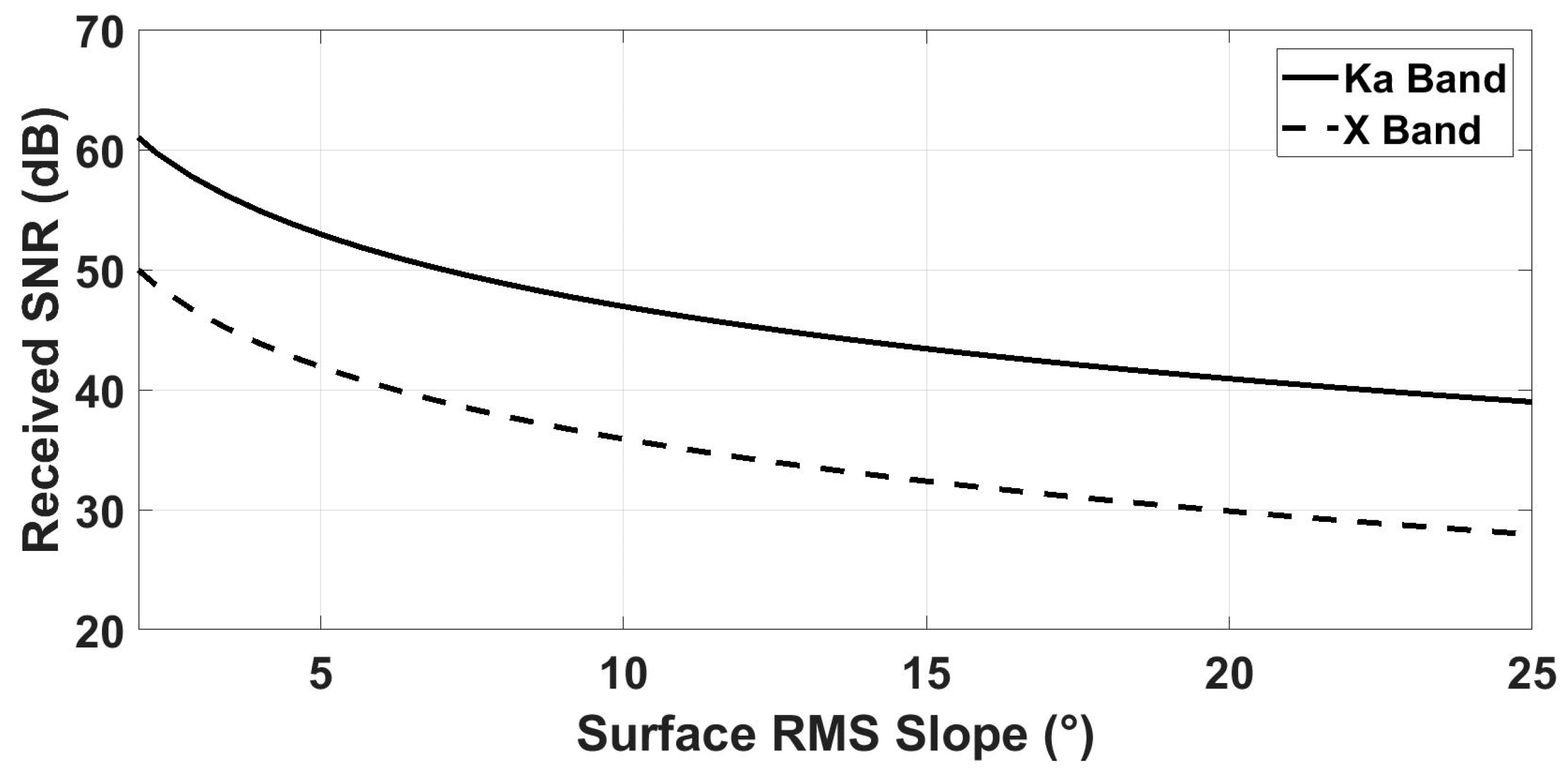
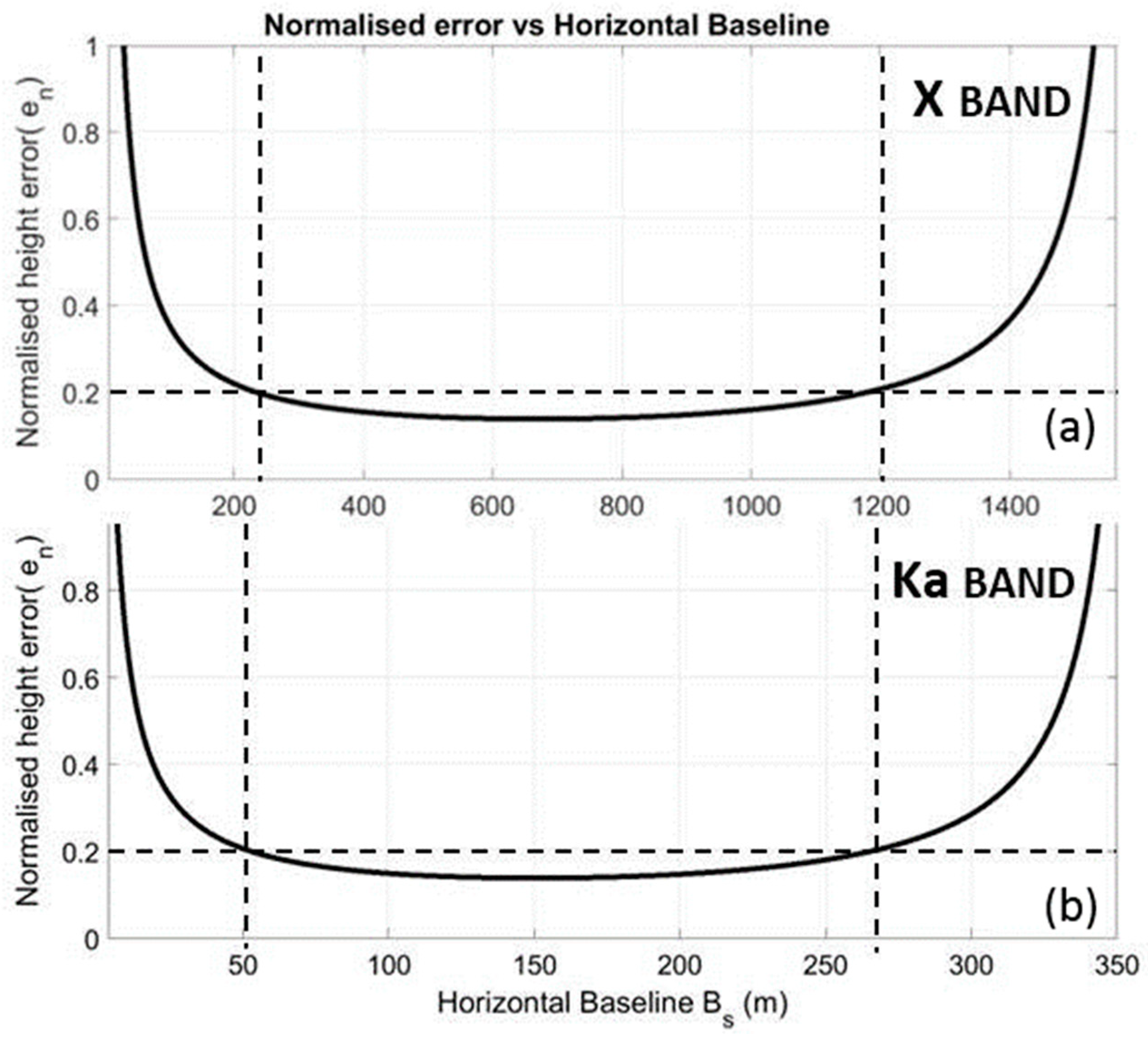
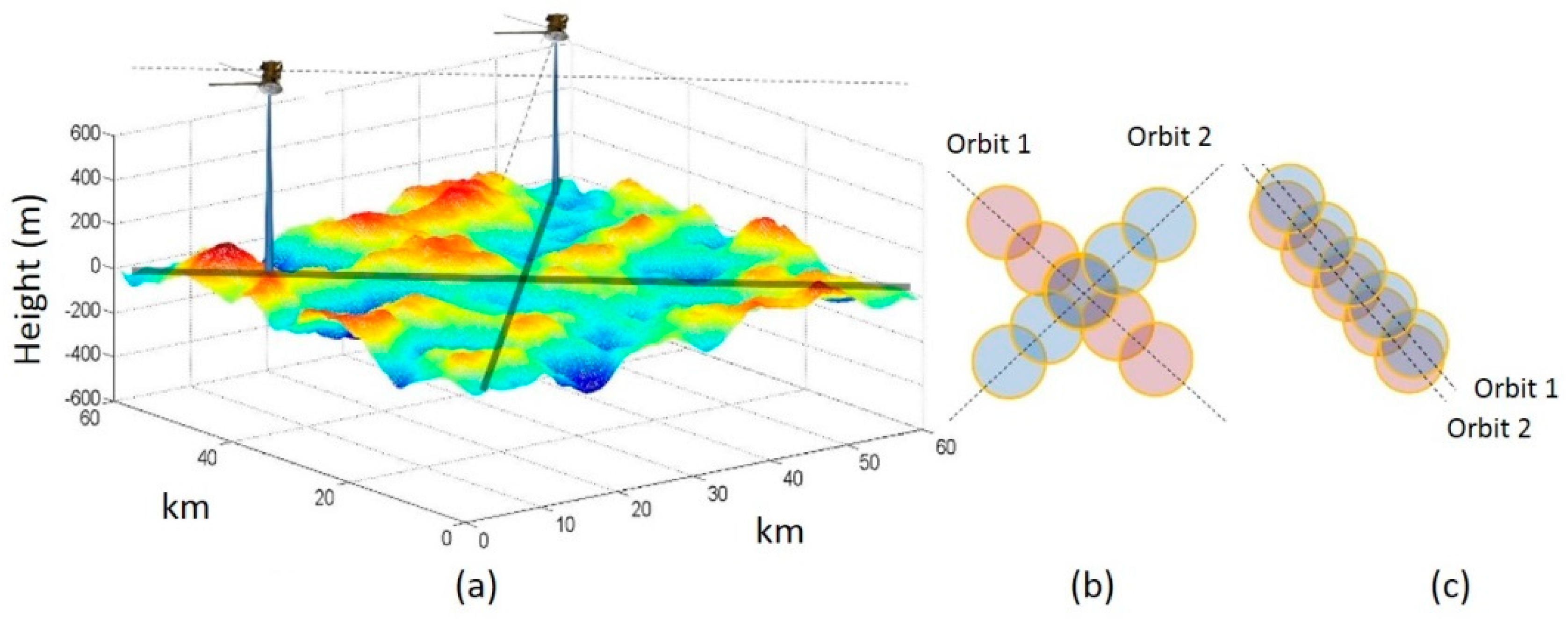
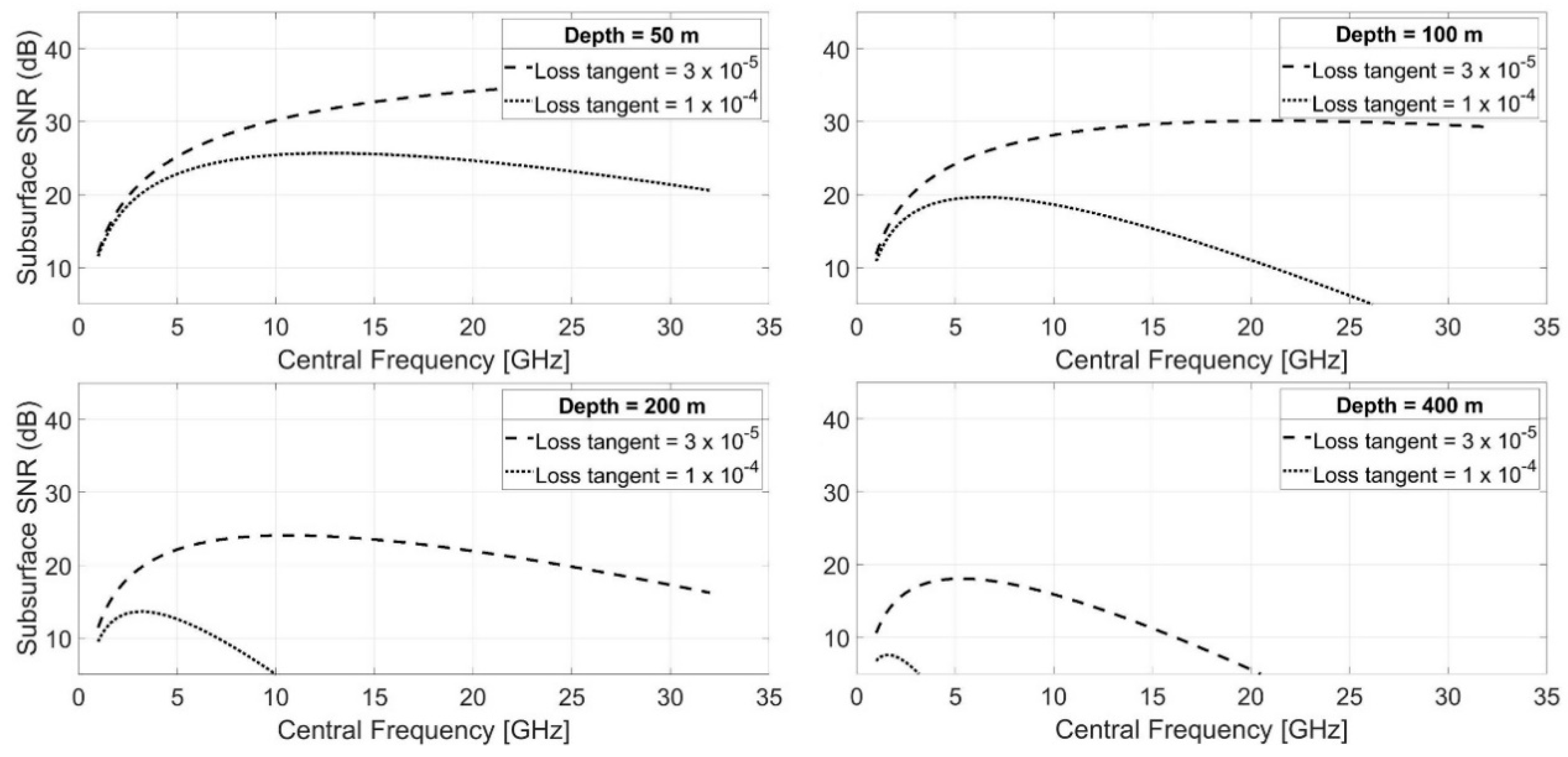
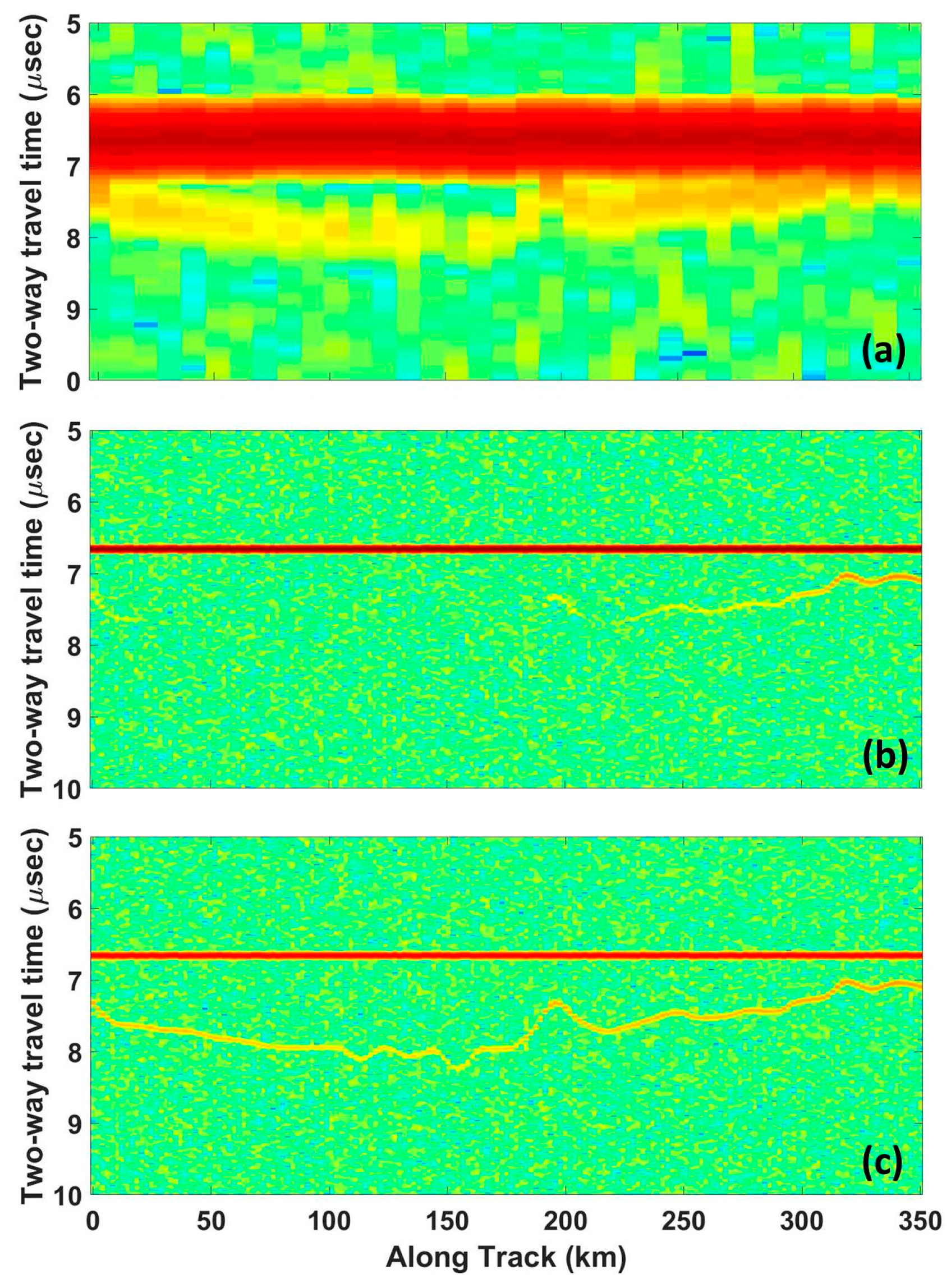
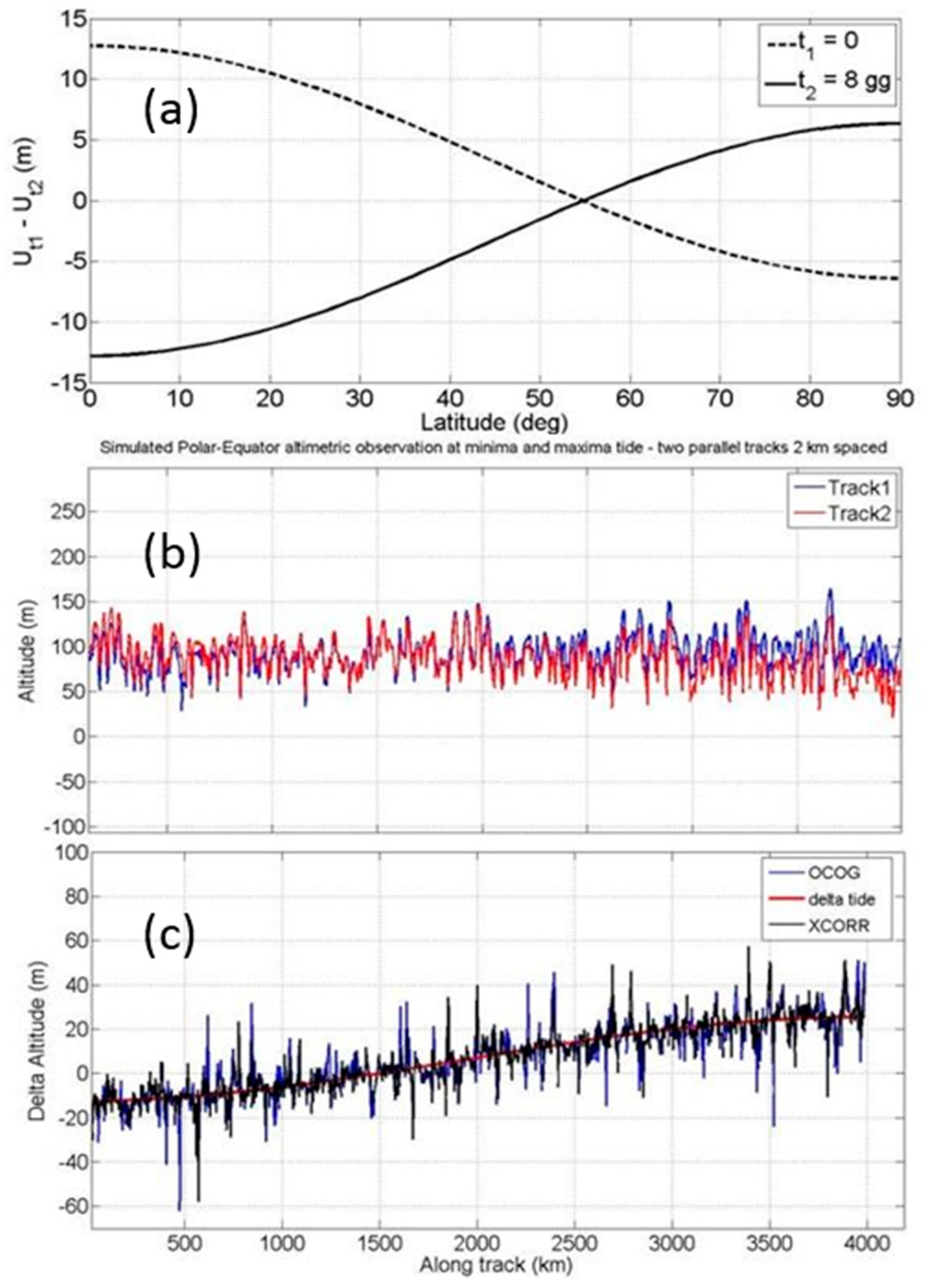
| Sea/Lake | Estimated Depths | Tan Delta | Latitude | Composition 1 CH4/C2H6/N2 | Epoch of Observation | Fly-By |
|---|---|---|---|---|---|---|
| Ligeia Mare | 20–170 m | 4 ± 1 × 10−5 | 77°–82°N | 71/12/17% | May 2013 | T91 |
| Punga Mare | 20–120 m | 3 ± 1 × 10−5 | 83°–84°N | 80/20/0% | January 2015 | T108 |
| Baffin Sinus | 20–60 m | 3 ± 1 × 10−5 | 80°–81°N | 80/20/0% | January 2015 | T108 |
| Winnipeg | 20–100 m | 4 ± 1 × 10−5 | 78°N | 69/15/16% | April 2017 | T126 |
| Ontario | 20–60 m | 6 ± 3 × 10−5 | 72°S | 47/40/13% | December 2008 | T49 |
| Kraken Mare | Not Detected | - | 60°–80°N | - | August 2014 | T104 |
| Symbol | Quantity | Unit | Value |
|---|---|---|---|
| Pt | Tx Power | [W] | 40 |
| L | Antenna size | [m] | 4 |
| Gant | Antenna Gain | [dB] | 54 (Ka) 42 (X) |
| T | Tx Chirp Length | [µs] | 150 |
| H | Altitude | [km] | 1500 |
| λ | Wavelength | [m] | 0.009 (Ka band) 0.04 (X band) |
| N | Pulses # | 45 | |
| B | Bandwidth | [MHz] | 50 |
| Teq | Eq. Temp. Rx | [K] | 1000 |
| K | Boltzmann constant | [J/K] | 1.38 × 10−23 |
| δr | Vertical res. | [m] | 3 |
| Raz | Horizontal res. | [m] | 6000 |
| Vt | Tangential Velocity | [km/s] | 1.5 |
| Requirements | Unit | Value |
|---|---|---|
| Ground Resolution | [m] | ≤20 |
| Height Measurements Accuracy | [m] | <5 |
| Height Resolution | [m] | <50 |
| Radiometric Resolution | [dB] | <1.2 |
| Noise Equivalent | [dB] | <−15 |
| Bh [km] | sigmaH [m] | Mean OCOG | Err OCOG | OCOG (%) | Mean xcor | Err xcor | XCOR 1 (%) |
|---|---|---|---|---|---|---|---|
| 3 | 20 | 1.50 | 0.027 | 1.79 | 1.50 | 0.026 | 1.72 |
| 3 | 30 | 1.41 1 | 0.040 | 2.86 | 1.42 | 0.04 | 2.83 |
| 2 | 20 | 1.42 | 0.025 | 1.77 | 1.44 | 0.017 | 1.21 |
| 1 | 20 | 1.45 | 0.012 | 0.84 | 1.45 | 0.005 | 0.32 |
| 0.6 | 30 | 1.47 | 0.012 | 0.83 | 1.45 | 0.004 | 0.25 |
| 0.3 | 30 | 1.44 | 0.008 | 0.57 | 1.45 | 0.002 | 0.13 |
© 2019 by the author. Licensee MDPI, Basel, Switzerland. This article is an open access article distributed under the terms and conditions of the Creative Commons Attribution (CC BY) license (http://creativecommons.org/licenses/by/4.0/).
Share and Cite
Mastrogiuseppe, M. Dual Frequency Orbiter-Radar System for the Observation of Seas and Tides on Titan: Extraterrestrial Oceanography from Satellite. Remote Sens. 2019, 11, 1898. https://doi.org/10.3390/rs11161898
Mastrogiuseppe M. Dual Frequency Orbiter-Radar System for the Observation of Seas and Tides on Titan: Extraterrestrial Oceanography from Satellite. Remote Sensing. 2019; 11(16):1898. https://doi.org/10.3390/rs11161898
Chicago/Turabian StyleMastrogiuseppe, Marco. 2019. "Dual Frequency Orbiter-Radar System for the Observation of Seas and Tides on Titan: Extraterrestrial Oceanography from Satellite" Remote Sensing 11, no. 16: 1898. https://doi.org/10.3390/rs11161898
APA StyleMastrogiuseppe, M. (2019). Dual Frequency Orbiter-Radar System for the Observation of Seas and Tides on Titan: Extraterrestrial Oceanography from Satellite. Remote Sensing, 11(16), 1898. https://doi.org/10.3390/rs11161898




